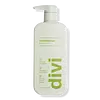What's inside
What's inside
 Key Ingredients
Key Ingredients

 Benefits
Benefits

 Concerns
Concerns

 Ingredients Side-by-side
Ingredients Side-by-side

Water
Skin ConditioningCetearyl Alcohol
EmollientGlycerin
HumectantAmodimethicone
Betaine
HumectantJojoba Esters
EmollientOrbignya Speciosa Kernel Oil
EmollientPentylene Glycol
Skin ConditioningBehentrimonium Methosulfate
Hydrogenated Soybean Oil
EmollientQuaternium-91
Cocos Nucifera Oil
MaskingGlyceryl Caprylate
EmollientHydroxyethylcellulose
Emulsion StabilisingPolyquaternium-73
Mentha Piperita Oil
MaskingHydroxyacetophenone
AntioxidantNiacinamide
SmoothingCetrimonium Methosulfate
AntimicrobialPolyquaternium-6
Caprylhydroxamic Acid
Panthenol
Skin ConditioningLactococcus Ferment Lysate
Skin ConditioningMelaleuca Alternifolia Leaf Oil
AntioxidantMenthol
MaskingSalix Alba Bark Extract
AstringentSimmondsia Chinensis Seed Oil
EmollientTetrasodium Glutamate Diacetate
Linum Usitatissimum Seed Oil
PerfumingSodium PCA
HumectantSodium Lactate
BufferingPolyquaternium-7
Arginine
MaskingAspartic Acid
MaskingPCA
HumectantCamellia Sinensis Leaf Extract
AntimicrobialAmaranthus Caudatus Seed Extract
Skin ConditioningBiotin
AntiseborrhoeicGlycine
BufferingLeptospermum Scoparium Branch/Leaf Oil
TonicOctyldodecanol
EmollientAlanine
MaskingSerine
MaskingValine
MaskingMagnolia Officinalis Bark Extract
AntimicrobialPiper Nigrum Seed Extract
RefreshingIsoleucine
Skin ConditioningProline
Skin ConditioningThreonine
Histidine
HumectantPhenylalanine
MaskingMyristoyl Pentapeptide-17
Skin ConditioningWater, Cetearyl Alcohol, Glycerin, Amodimethicone, Betaine, Jojoba Esters, Orbignya Speciosa Kernel Oil, Pentylene Glycol, Behentrimonium Methosulfate, Hydrogenated Soybean Oil, Quaternium-91, Cocos Nucifera Oil, Glyceryl Caprylate, Hydroxyethylcellulose, Polyquaternium-73, Mentha Piperita Oil, Hydroxyacetophenone, Niacinamide, Cetrimonium Methosulfate, Polyquaternium-6, Caprylhydroxamic Acid, Panthenol, Lactococcus Ferment Lysate, Melaleuca Alternifolia Leaf Oil, Menthol, Salix Alba Bark Extract, Simmondsia Chinensis Seed Oil, Tetrasodium Glutamate Diacetate, Linum Usitatissimum Seed Oil, Sodium PCA, Sodium Lactate, Polyquaternium-7, Arginine, Aspartic Acid, PCA, Camellia Sinensis Leaf Extract, Amaranthus Caudatus Seed Extract, Biotin, Glycine, Leptospermum Scoparium Branch/Leaf Oil, Octyldodecanol, Alanine, Serine, Valine, Magnolia Officinalis Bark Extract, Piper Nigrum Seed Extract, Isoleucine, Proline, Threonine, Histidine, Phenylalanine, Myristoyl Pentapeptide-17
Water
Skin ConditioningCetearyl Alcohol
EmollientBehentrimonium Chloride
PreservativeElaeis Guineensis Oil
EmollientCetyl Alcohol
EmollientIsopropyl Alcohol
SolventPhenoxyethanol
PreservativeStearamidopropyl Dimethylamine
EmulsifyingOctyldodecanol
EmollientSodium PCA
HumectantParfum
MaskingCitric Acid
BufferingSodium Cocoyl Amino Acids
CleansingChlorhexidine Dihydrochloride
AntimicrobialStearyl Alcohol
EmollientMyristyl Alcohol
EmollientPotassium Dimethicone PEG-7 Panthenyl Phosphate
Skin ConditioningSodium Sarcosinate
Propylene Glycol
HumectantArgania Spinosa Kernel Oil
EmollientArginine
MaskingHydrolyzed Soy Protein
HumectantHydrolyzed Vegetable Protein Pg-Propyl Silanetriol
Skin ConditioningSodium Chloride
MaskingTetrasodium EDTA
Potassium Sorbate
PreservativeWater, Cetearyl Alcohol, Behentrimonium Chloride, Elaeis Guineensis Oil, Cetyl Alcohol, Isopropyl Alcohol, Phenoxyethanol, Stearamidopropyl Dimethylamine, Octyldodecanol, Sodium PCA, Parfum, Citric Acid, Sodium Cocoyl Amino Acids, Chlorhexidine Dihydrochloride, Stearyl Alcohol, Myristyl Alcohol, Potassium Dimethicone PEG-7 Panthenyl Phosphate, Sodium Sarcosinate, Propylene Glycol, Argania Spinosa Kernel Oil, Arginine, Hydrolyzed Soy Protein, Hydrolyzed Vegetable Protein Pg-Propyl Silanetriol, Sodium Chloride, Tetrasodium EDTA, Potassium Sorbate
 Reviews
Reviews

Ingredients Explained
These ingredients are found in both products.
Ingredients higher up in an ingredient list are typically present in a larger amount.
Arginine is an amino acid that is important for human development. Your body uses is it to produce hair keratin and skin collagen.
As a cosmetic ingredient, Arginine has antioxidant properties and can also help repair damaged skin. This ingredient is derived either synthetically or from animals.
Arginine isn't fungal acne safe when used in the presence of other lipids (fats, fatty acids, oils, esters, etc). Oils and fats occur naturally within the skin, so take caution when using Arginine if you're prone to fungal acne.
Learn more about ArginineCetearyl alcohol is a mixture of two fatty alcohols: cetyl alcohol and stearyl alcohol. It is mainly used as an emulsifier. Emulsifiers help prevent the separation of oils and products. Due to its composition, it can also be used to thicken a product or help create foam.
Cetearyl alcohol is an emollient. Emollients help soothe and hydrate the skin by trapping moisture.
Studies show Cetearyl alcohol is non-toxic and non-irritating. The FDA allows products labeled "alcohol-free" to have fatty alcohols.
This ingredient is usually derived from plant oils such as palm, vegetable, or coconut oils. There is debate on whether this ingredient will cause acne.
Due to the fatty acid base, this ingredient may not be Malassezia folliculitis safe.
Learn more about Cetearyl AlcoholOctyldodecanol is a fatty alcohol. It is primarily used to enhance the texture of products.
As an emulsifier, Octyldodecanol helps prevent the oils and waters from separating. It also prevents ingredients from creating foam when shaken.
Octyldodecanol is created by reducing fatty acid to an alcohol.
Due to its high molecular weight, it does not get absorbed into the skin.
Learn more about OctyldodecanolSodium PCA is the sodium salt of pyroglutamic acid. It is naturally occurring in our skin's natural moisturizing factors where it works to maintain hydration.
The PCA stands for pyrrolidone carboxylic acid, a natural amino acid derivative.
This ingredient has skin conditioning, anti-inflammatory, and humectant properties. Humectants help hydrate your skin by drawing moisture from the air. This helps keep your skin moisturized.
Learn more about Sodium PCAWater. It's the most common cosmetic ingredient of all. You'll usually see it at the top of ingredient lists, meaning that it makes up the largest part of the product.
So why is it so popular? Water most often acts as a solvent - this means that it helps dissolve other ingredients into the formulation.
You'll also recognize water as that liquid we all need to stay alive. If you see this, drink a glass of water. Stay hydrated!
Learn more about Water